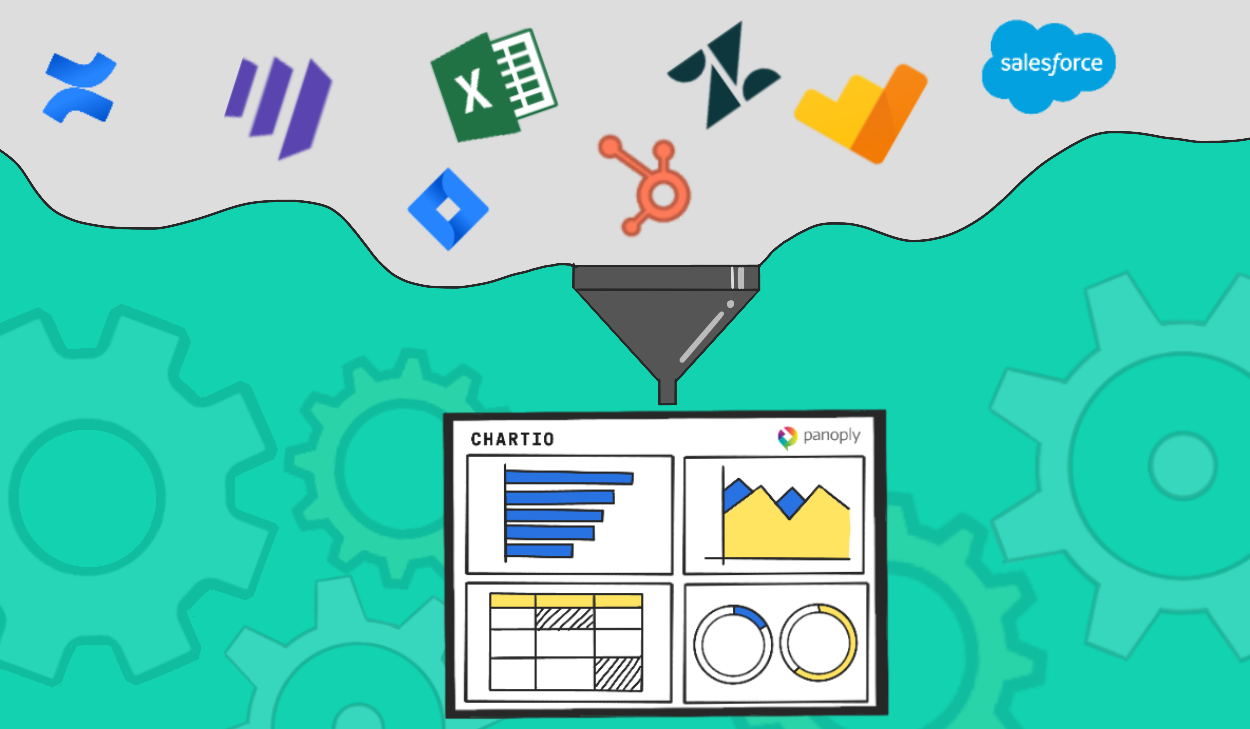4 Steps to Manage Your Data Program
Posted by on June 24, 2020 Chartio
It’s a love and hate relationship between data and its users. We love the possibilities data presents, but getting there….. (sigh….) it’s nothing short of a journey.
Gallup states that “85% of execs don’t know how to analyze the data they’re collecting and that 60% of data projects fail to get beyond the pilot stage.”
Holy gap.
We know we need data, but we struggle to find the path to answers. By understanding the challenges data and data management present, companies can better approach the whole process and bypass what doesn’t matter, while staying hyper-focused on accelerating insights to drive impact.
Datateer and Chartio are at the forefront of the challenge and the solution. Last week, Chartio’s Head of Partnerships Jaron Farnham and Datateer’s Founder/CEO Adam Roderick got together to examine the landscape and provide our communities with a step-by-step approach to modern data management: one that doesn’t take months or millions of dollars, but can scale with your business by taking a simpler approach.
We don’t claim to have all the answers. But we do believe the benefits are within arm’s reach – you just need the right blueprint.
Decide what to measure
An average employee uses eight SaaS applications to perform day-to-day functions. Eight! How does that add up? Wait for it… Companies with 50 or fewer employees have about 40 different applications in total, while those with 1000+ employees have over 200. With so many tools—each with its own data that could be analyzed—there is no question that data becomes overwhelming. But these tools provide a necessary service, so you must ask yourself: ‘What’s important and what do I need to look at?’
It’s like the example Adam shared, “I took my five daughters to a candy store and they were so pumped. But then I gave them each a buck and they didn’t know where to start.” You won’t be able to sift through your data to draw meaningful insights until you narrow it down.
I’ll be the first to say it, I forget how much I rely on technology to do my job well and sometimes take for granted the tools I have at my disposal. And the data usually takes a back seat until I need it. Take HubSpot for example. I can’t run an influence report without it, but if I try to look at the information in the context of other things, like closed won ARR based on first content seen, it becomes an entirely different beast. Then I start wondering: ‘What data should I focus on first?’
Leading SaaS vendors like HubSpot and Salesforce structure their data based on how they like to work. This doesn’t necessarily align well with how you or I work. Multiply that by 40 other SaaS tools, and we’re in pain.
What I should do before I start running influence reports is to step back and ask: ‘As a marketer who runs Demand Generation, what are the metrics I should focus on and why? What will they tell me? How will they influence my programs and my investments? How will they help our business grow?’ If I ask myself about the specifics, I can get a better answer.
“It’s really easy to boil the ocean when it comes to data and it’s important to know where the priorities are and what type of data will have the highest impact. Once you have that, you can optimize how best to put that data into a readable format so your teams can march to the beat of the same step.” Adam Roderick, Datateer.
Eliminate the falsehoods of data management
If you’re thinking, “We’re at least X months away from having the infrastructure and/or being able to spend the money and resources on BI like Chartio,” you’re not alone. These misperceptions are a product of how we were introduced to traditional BI combined with the highly complex platforms that still dominate Enterprise. This foundation created a paradigm that was timely, expensive, and complex, and took multiple teams to engineer and implement. Fortunately, now those legacies are fading, but their fears continue to linger. Here’s what we’ve learned and our advice to change a falsehood into opportunity:
Falsehood 1: “It’s going to take us too long to get organized”
Data management is a big project, we’re not discounting, but there are partners that exist to help take on that burden for you. As mentioned earlier in the post, the average company works with 40 SaaS applications. The thought of writing integrations to bring all this data together seems mind-numbing. Today, there are partners like Fivetran and Stitch that automate aggregating customer data from disparate systems into a single data store, freeing up your teams to focus on impact. You no longer have to deal with the burden of building multiple connectors to create a single source of truth.
Falsehood #2: “This project is too complex”
Some areas of data and business intelligence are changing dramatically. The processing power of storage has increased significantly, there are new open source modeling frameworks and brand new tools to automate difficult data tasks. But data management books haven’t been updated in a decade. With a significant portion of the data market being self-taught, this creates a huge discrepancy between what is now offered and what people learn from those outdated sources. The project may be complex, but the way to approach it has in fact been simplified. Businesses can now approach their data in a quick and agile way with technology partners like Datateer and Chartio.
Falsehood #3: “Enterprise solutions are too costly”
Companies like Redshift, BigQuery, and Snowflake now offer a consumption model, which is relatively cheap compared to what was offered before. Businesses can now quickly spin up a cloud warehouse with a couple hundred dollars without having a 12-24 month license commitment, lowering the risk.
Own your stage
Chartio just turned 10! In this past decade, we’ve listened, learned and listened some more. We’ve worked with data teams of one, five, sometimes 20+, and we’ve explored a variety of architectures, tools, and platforms. Through our experiences, we’ve built up an encyclopedia of data management insights on what works and what doesn’t. We organized these insights into a book we call “Cloud Data Management (4 Stages for Informed Companies),” which has become the blueprint for successful organizations who are trying to make sense of their data to accelerate smarter impact. And in the context of our conversation around modernizing your approach to data management, these stages are key as they clearly describe the journey a company goes through as they need to analyze more data and evolve their data stack.
We have identified 4 stages that companies go through with their data sophistication; source, lake, warehouse and mart. And while no stage is necessarily better than the other, in order to work smart with data, you need to understand what stage your business is at. Here they are:
Stage 1: Source
We typically see small companies fall under this stage. Individuals purchase their own applications to run their part of the business, and people are leveraging data from those applications individually to report the performance.
Stage 2: Lake
Companies that fall under the lake stage are roughly in the 25-100 employee size range. People are starting to think about putting different metrics into one place to get a holistic understanding of data from different sources.
Stage 3: Warehouse
Also referred to as the single source of truth, this is the stage where companies get alignment around specific metrics. The transition from lake to warehouse stage is usually where businesses struggle the most because it’s when people have to work together to get clarity and be aligned on different metric definitions.
Stage 4: Mart
This is a smaller, more specific source of truth for a team or topic of investigation. This can really enable everyone in the organization to use data!

4 steps to take today
Step 1: With so much data being collected and stored, it can be easy to get lost in the weeds without focus. Adam suggests, “Limit your first efforts to one audience to begin with. If you let yourself answer ten different questions for ten different audiences, you’re not going to make great progress.” If this step is done correctly, you’ll be able to get quick wins and value within weeks, instead of months.
Step 2: Once you have your focus, the next step is getting aligned with how you define “metrics” across your company. Even a simple term like “customer” can have different meanings for sales, CS, and finance teams. Going through this exercise can be time consuming and painful, but it’s a crucial step to move forward as finding focus and consistency will allow you to create assets you can refer back to later to make your implementation process easier.
Step 3: Once you have your question, audience, and strategy down, you need to ask yourself: “Do we have the data to answer the questions and metrics in the way we’ve defined them?” Then you can bring your data together in one place in an analytical data model, a canonical representation of your data that defines how your business operates.
Step 4: The last step is to operate and iterate on these processes. “Things are going to break with so many moving parts, so adding a process to solve that as part of the operations might be helpful.” Adam concluded.
“The point of all this is to exercise some focus, prioritization, alignment and process. And if you can create a repeatable process that is simple enough, you can take small steps in evolving your data environment to leverage data to increase revenue and productivity,” Jaron stated.
Adam and Jaron shared some great lessons. And while we captured most of them here, we do encourage you to check out their full conversation here.


